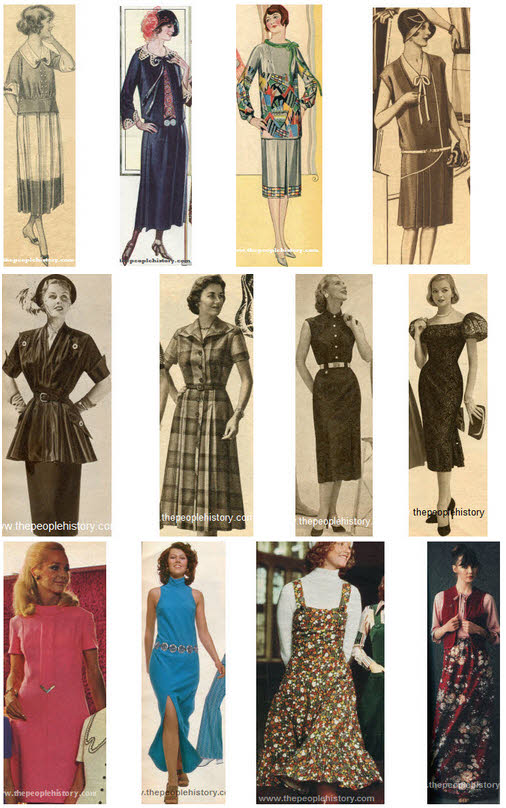In the 1920s, the decade soon after the end of World War I, skirt and dress hemlines rose and waist lines lowered to the hip. This came because of a newfound appreciation of femininity and female sexual liberation. These changes accompanied flapper fashions and marked the Roaring Twenties as a decade of decadence. From 1926 to 1928, hemlines were, reportedly, at their shortest, however once the stock market crashed in 1929 and the Great Depression set in, hemlines returned to more conservative lengths.
In the 1930s, Hollywood glamour was idolized, leading to a return to femininity. Evening gowns were made luxuriously with chiffon or velvet. More casual looks were slim-cut and had wide shoulders often accompanied with a belt around the waist. Floral prints and (real) fur accents were all the rage in this decade, however, they soon went out of fashion once World War II broke out.
During World War II, fabrics like wool, silk, and nylon were considered a luxury and were highly regulated, thus women's dresses and skirts were made of a much cheaper material: viscose. Such skirts and dresses were also, often times, made of anything that could be found within a home (curtains, nightgowns, or bed sheets) due to the illegality of using excess fabric when making an outfit from 1942 to 1947.
The economic boom in the 1950s, glamour became fashionable once again; in this decade, A-line and pencil skirts (form-fitting fashions) became very popular. Dresses in this time often featured stylish ruffles or lace accents and were usually knee-length. These longer dresses came at a time when women, influenced by the need to conform, regressed back into more domestic, less independent roles.
 In the late 1950s and the 1960s, mini-dresses and maxi-length skirts entered the fashion scene. Mod styled dresses with short skirts and bold, colorful patterns became popular. '
In the late 1950s and the 1960s, mini-dresses and maxi-length skirts entered the fashion scene. Mod styled dresses with short skirts and bold, colorful patterns became popular. '
In the late 1960s and early 1970s, hippie fashion took over; loose-fitting, flowing maxi-skirts and dresses became the dominant trend. The popularity of disco music and dance also influenced the way dresses were styled--with slender lines, flowing skirts, and shimmering fabrics--so that said dresses would look good in night clubs.
Fashion evolved once again in the Eighties. Skirts and dresses were, again, longer and featured straight lines and a more serious kind of design. As more and more women began working, business suits became a trend for women--straight conservative skirts and broad shouldered, boxy blazers. During this decade, fashion became highly effected by music and movie stars such as Madonna, Cyndi Lauper, and Molly Ringwald.
In the 1990s, skirts and dresses became less and less prominent, while more casual styles became more acceptable. Hip hop and alt music set the scene for fashion early in the decade. Skirts and dresses were usually short and provocative, however loose and flowing dresses, as well as long denim skirts, were also notable trends.
Fashion for women has changed significantly with each decade, each of the trends have mirrored the state of the country at the time in both economic and social terms.
No comments:
Post a Comment